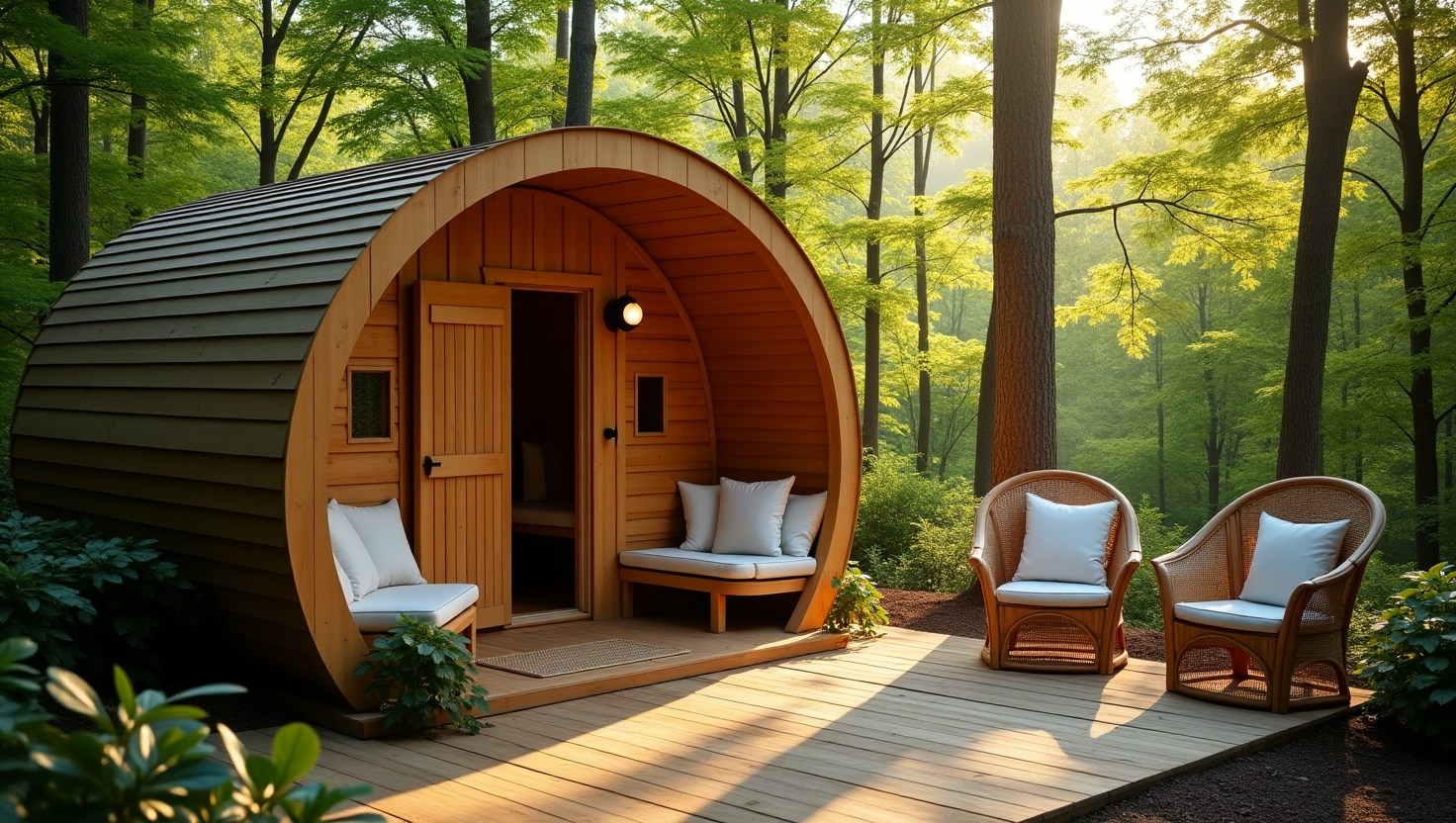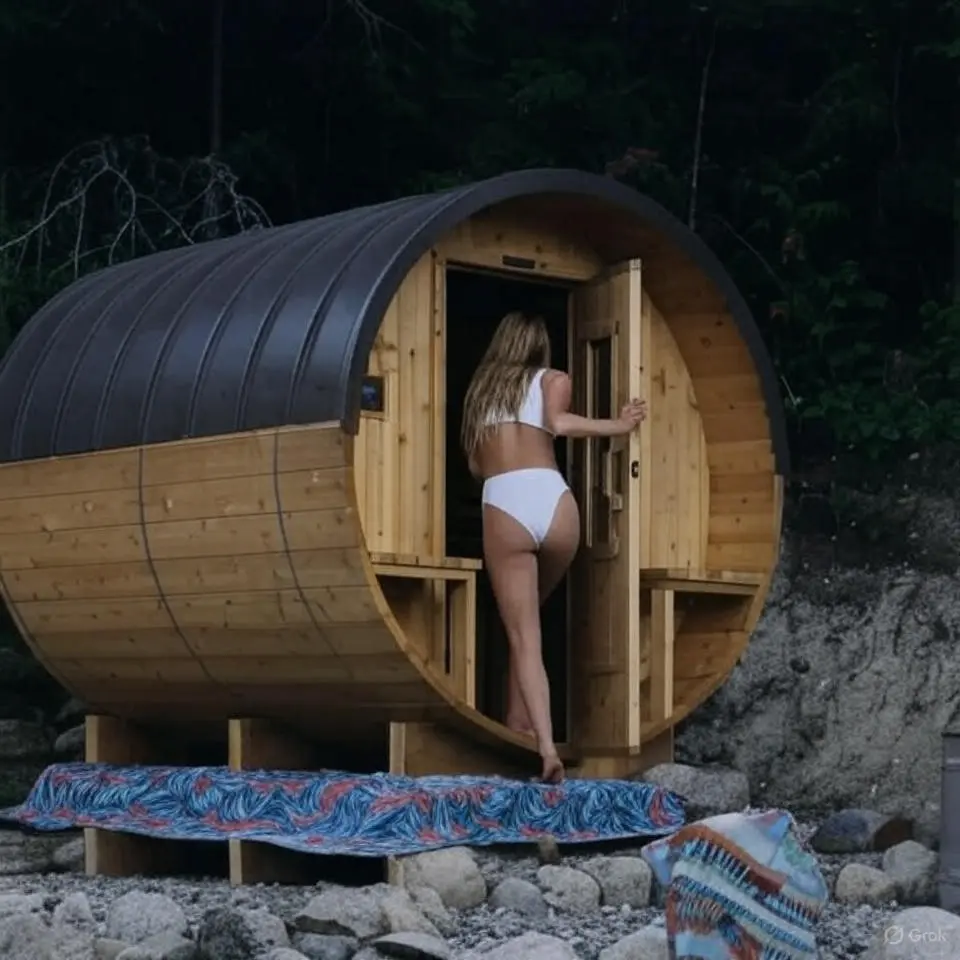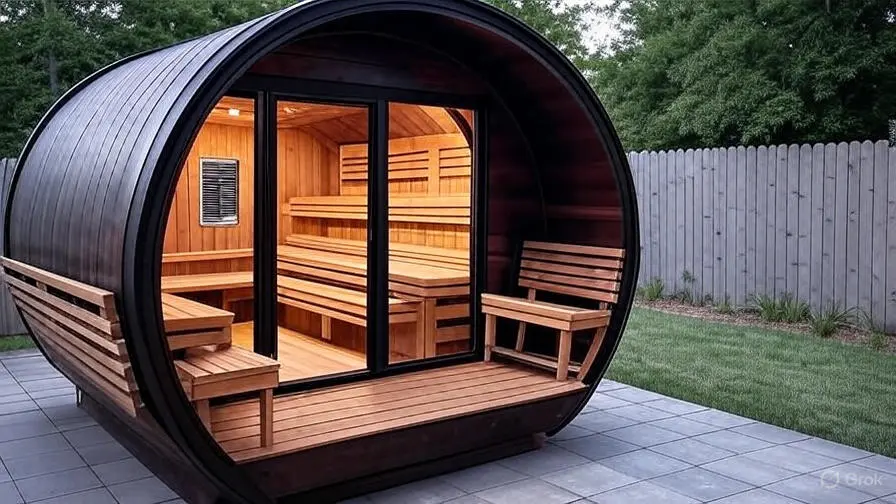Did you know saunas boost your heart health? Outdoor saunas are cozy retreats in your backyard. They offer relaxation and wellness. Moreover, they blend nature with comfort. This guide covers size, materials, temperature, and thermostats. So, let’s dive into the best outdoor sauna essentials.
Why Outdoor Saunas Are Gaining Popularity
Outdoor saunas are trending now. First, they save indoor space. Next, they connect you with nature. Also, people love unique backyard features. Homeowners seek wellness at home. Therefore, outdoor saunas are a top choice.
Health and Lifestyle Benefits
Saunas improve blood flow. They reduce stress. Additionally, they help muscles recover. You sleep better after a session. Furthermore, saunas boost skin health. So, they enhance your lifestyle.
| Benefit | Description |
| Detoxification | Sweating helps flush out toxins and impurities from the body. |
| Improved Circulation | Heat stimulates blood flow, improving heart and vessel health. |
| Stress Relief | Relaxing in a sauna reduces cortisol levels and eases tension. |
| Better Sleep | Post-sauna relaxation promotes deeper, more restful sleep. |
| Muscle Recovery | Heat helps soothe sore muscles and reduce post-workout inflammation. |
| Boosted Immunity | Regular sauna use can enhance white blood cell production. |
| Skin Health | Opened pores and improved blood flow can lead to clearer, healthier skin. |
| Weight Support | Heat exposure slightly raises heart rate and calorie burn. |
| Mental Clarity | Quiet time in a sauna supports mindfulness and focus. |
| Social Wellness | Group sauna sessions encourage bonding and shared relaxation. |
Choosing the Right Size for Your Outdoor Sauna
Size matters for comfort. First, consider your space. Next, think about users. Then, plan for future needs. Here’s how to pick the perfect size.
| Sauna Size | Dimensions (Approx.) | Capacity | Best For | Pros | Cons |
| Small | 4′ x 4′ to 4′ x 6′ | 1–2 people | Solo use, couples, small patios | Compact, budget-friendly, fast to heat | Limited space, less social |
| Medium | 5′ x 6′ to 6′ x 8′ | 3–4 people | Small families, friends, average backyards | Balanced size, good for sharing | Needs moderate space |
| Large | 6′ x 8′ and larger | 5+ people | Big families, social gatherings, home spas | Spacious, luxurious, high capacity | Higher cost, longer heating time |
| Custom | Varies | Any | Specific needs, unique spaces | Full design control, fits special layouts | Expensive, requires planning |
1–2 Person Saunas: Compact and Cozy
Small saunas fit tight spaces. They suit couples or solo users. Also, they use less power. You save on costs. Moreover, they heat up fast. So, compact saunas are practical.
3–4 Person Saunas: Family-Friendly Choices
Mid-size saunas suit families. They fit 3–4 people. Also, they balance space and comfort. You get room for guests. Furthermore, they suit most backyards. Therefore, they’re versatile.
5+ Person Saunas: Social and Spacious
Large saunas host groups. They fit 5 or more people. Also, they’re great for parties. You enjoy social vibes. Moreover, they offer extra seating. So, they’re ideal for gatherings.
Custom vs. Prefab Sauna Sizes
Custom saunas match exact needs. You design the size. However, they cost more. Prefab saunas come ready-made. They save time. Also, they’re budget-friendly. So, choose based on needs.
Best Materials for Outdoor Saunas
Materials affect durability. First, pick strong woods. Next, ensure weather resistance. Then, focus on insulation. Here’s what works best.
| Material | Use (Interior/Exterior) | Benefits | Drawbacks | Durability |
| Western Red Cedar | Both | Aromatic, rot-resistant, low heat conductivity | Higher cost | 🌟🌟🌟🌟🌟 Excellent |
| Nordic Spruce | Exterior | Affordable, light color, weather-resistant | Needs regular sealing | 🌟🌟🌟🌟 Good |
| Thermowood | Both | Heat-treated, eco-friendly, stable in all climates | Slightly darker appearance | 🌟🌟🌟🌟🌟 Excellent |
| Hemlock | Interior | Smooth finish, non-toxic, splinter-free | Less aromatic than cedar | 🌟🌟🌟🌟 Good |
| Aspen | Interior | Soft, splinter-free, odorless | Prone to staining if untreated | 🌟🌟🌟 Moderate |
| Pine | Exterior (sometimes interior) | Affordable, easy to work with | Needs frequent treatment | 🌟🌟 Fair |
Exterior Wood Types: Cedar, Spruce, and Thermowood
Cedar resists rot. It smells great. Also, it looks beautiful. Spruce is affordable. It’s sturdy too. Thermowood handles humidity. So, these woods last long.
Interior Wood Options: Aspen, Hemlock, and Cedar
Aspen stays cool. It’s gentle on skin. Also, it’s hypoallergenic. Hemlock is smooth. It resists moisture. Cedar adds aroma. Therefore, these create cozy interiors.
Weatherproofing and Insulation Tips
Seal wood with stains. It protects from rain. Also, insulate walls well. You keep heat inside. Furthermore, check seals yearly. So, your sauna stays strong.
Ideal Temperature Settings for Outdoor Saunas
Temperature sets the mood. First, know sauna types. Next, adjust for comfort. Then, monitor safety. Here’s how to set it right.
Traditional Sauna Temperature Ranges
| Temperature (°F) | Temperature (°C) | Experience Level | Benefits | Notes |
| 150°F | 65°C | Beginner | Gentle warmth, light sweating | Good starting point for new users |
| 160°F | 71°C | Moderate | Moderate sweating, muscle relaxation | Start to feel deeper body heat |
| 170°F (ideal) | 77°C | Intermediate to Advanced | Deep sweating, improved circulation, detoxification | Most users consider this the optimal experience level |
| 180°F | 82°C | Advanced | Intense sweating, deep tissue relaxation | Shorter sessions recommended |
| 195°F | 90°C | Expert | Maximum heat, extreme detox potential | Only for seasoned sauna-goers; hydrate well |
Infrared Sauna Temperature Settings
| Feature | Details |
| Temperature Range | 120°F to 140°F |
| Heating Method | Direct body heating (not air) |
| Benefits | Deep skin penetration, relaxation, detoxification |
| Comfort Level | More tolerable than traditional saunas |
| Recommended Use | Longer sessions due to lower ambient heat |
| User Tip | Start at a lower temperature and increase gradually |
| Health Consideration | Adjust based on individual comfort and medical guidance |
Factors That Affect Sauna Heating
Size impacts heat time. Insulation keeps warmth in. Also, heater power matters. Weather affects outdoor saunas. Moreover, ventilation balances heat. So, check these factors.
Safety Tips for Heat Management
| Safety Tip | Description |
| Start with lower temperatures | Begin at a low setting and increase gradually to avoid heat shock. |
| Limit sessions to 15–20 minutes | Helps prevent overheating and dehydration. |
| Stay hydrated | Drink water before and after each session to maintain fluid balance. |
| Avoid alcohol and heavy meals | These can impair your body’s ability to regulate heat. |
| Step out if feeling dizzy or lightheaded | A sign of overheating—exit immediately for safety. |
| Use a timer | Keeps your sauna sessions within safe time limits. |
| Install a reliable thermostat and ventilation system | Maintains consistent temperature and airflow for safety and comfort. |
| Supervise children and elderly | They are more sensitive to heat and need extra care. |
| Cool down slowly after each session | Allows your body to adjust gradually and safely return to normal temperature. |
Understanding Sauna Thermostats
Thermostats control heat. First, pick a reliable type. Next, ensure easy use. Then, focus on safety. Here’s what you need.
Manual vs. Digital Thermostats
Manual thermostats are simple. You turn a dial. Also, they’re budget-friendly. Digital ones show exact temperatures. They’re user-friendly. So, choose based on preference.
Smart Thermostats: Remote Control & Scheduling
| Feature | Description |
| Remote Control | Manage sauna temperature from your smartphone or tablet. |
| Preheating | Set the heat before you arrive for instant relaxation. |
| Learning Habits | Some models adjust automatically based on your usage patterns. |
| Energy Saving | Turns on and off at optimal times to reduce power use. |
| Timers & Alerts | Built-in safety with auto shut-off and temperature warnings. |
| Ease of Use | Makes managing your sauna convenient, efficient, and modern. |
Built-in Timers and Safety Shutoffs
Timers limit session time. They prevent overheating. Also, safety shutoffs stop power if too hot. You stay protected. Furthermore, they’re standard in good saunas. So, always check for these.
Installation Tips and Layout Planning
Installation needs planning. First, pick a spot. Next, ensure a solid base. Then, set up power. Here’s how to do it.
Location, Foundation, and Drainage Needs
Place saunas on flat ground. Avoid wet areas. Also, use concrete or gravel bases. They stay stable. Moreover, ensure good drainage. So, water won’t pool.
Power Supply and Wiring Considerations
| Aspect | Details |
| Power Supply Type | Dedicated circuit recommended |
| Voltage Requirements | 220V for traditional heaters; 110V for some infrared saunas |
| Amperage Needs | Depends on heater size; check manufacturer specs |
| Wiring Safety | Use weatherproof conduit and outdoor-rated cables |
| Electrical Protection | GFCI breakers and surge protection required |
| Grounding | Essential for safety and electrical compliance |
| Installation Tip | Always hire a licensed electrician for setup |
| Model-Specific Requirements | Always refer to your sauna’s electrical manual |
Ventilation and Airflow Design
Vents keep air fresh. Place them low and high. Also, they control humidity. You breathe easier. Moreover, good airflow prevents mold. So, plan vents carefully.
Maintenance and Longevity Tips
Maintenance keeps saunas new. First, clean often. Next, protect from weather. Then, check parts yearly. Here’s how to do it.
Cleaning and Treating Wood Surfaces
Wipe benches after use. Use mild soap. Also, sand rough spots. Apply wood sealant yearly. Moreover, avoid harsh chemicals. So, wood stays smooth.
Seasonal Weather Protection
Cover saunas in winter. Check for leaks. Also, clear snow off roofs. Seal cracks before rain. Furthermore, inspect after storms. So, your sauna lasts longer.
Cost Overview: Budgeting for Outdoor Saunas
Saunas vary in price. First, know your budget. Next, compare options. Then, plan for upkeep. Here’s a breakdown.
| Item/Category | Estimated Cost (USD) | Details |
|---|---|---|
| DIY Sauna Kit | $1,500 – $4,000 | Basic materials only; tools and labor not included |
| Custom-Built DIY Sauna | $3,000 – $10,000+ | Includes higher-end materials, insulation, and roofing |
| Prefab Sauna (2–4 person) | $3,000 – $7,000 | Includes walls, benches, heater, often easy to assemble |
| Luxury Prefab Sauna (5+ person) | $7,000 – $15,000+ | Premium wood, smart controls, glass doors, added design features |
| Heater (Electric/Wood) | $300 – $1,500+ | Electric cheaper; wood-burning adds installation and ventilation costs |
| Foundation/Base Prep | $300 – $1,000+ | Concrete slab, gravel, or deck platform |
| Insulation & Vapor Barrier | $200 – $800 | Needed for cold climates or improved efficiency |
| Electrical Setup | $500 – $2,000 | Professional wiring for heaters, lights, thermostats |
| Roofing & Weatherproofing | $200 – $1,000+ | Shingles, sealants, and protective coatings |
| Labor (if hired) | $500 – $5,000+ | Depending on local rates and sauna complexity |
| Maintenance Tools/Supplies | $100 – $300 annually | Cleaners, brushes, wood treatment, thermometer replacements |
DIY vs. Prefab Cost Comparison
| Feature | DIY Sauna | Prefab Sauna |
| Cost Range | $1,500 – $4,000 (some up to $10,000) | $3,000 – $15,000 |
| Labor | Self-built; no labor costs | Labor included or minimal setup required |
| Skill Needed | High – requires tools, carpentry, planning | Low – simple assembly or plug-and-play |
| Time to Install | Longer – several days or weeks | Fast – some install in hours |
| Quality Control | You choose materials and design | Factory precision and tested builds |
| Warranty | None (unless on parts) | Often included |
| Customization | Fully customizable | Limited to manufacturer options |
| Best For | Budget-conscious, hands-on individuals | Convenience-seekers, less DIY experience |
| Value Over Time | High with proper build | High with proper care |
Long-Term Investment Benefits
Saunas boost home value. They save spa trips. Also, they improve health. You spend less on stress relief. Moreover, they last 15–20 years. So, they’re worth it.
Visual Inspiration: Outdoor Sauna Design Ideas
Designs spark creativity. First, explore styles. Next, match your home. Then, add personal touches. Here are top ideas.
Modern, Scandinavian, Rustic, and Minimalist Styles
Modern saunas use glass. They look sleek. Also, Scandinavian styles are cozy. They use light wood. Rustic saunas feel natural. Minimalist ones are simple. So, pick your vibe.
Conclusion: Build Your Perfect Outdoor Sauna
Outdoor saunas bring joy. They improve health. Also, they fit any yard. Choose size, materials, and thermostats wisely. Moreover, plan installation well. So, enjoy the best sauna experience!
FAQs About Outdoor Saunas
What size outdoor sauna is best for 2 people?
A 1–2 person sauna works great. It’s compact. Also, it fits small yards. You get cozy vibes. So, it’s perfect for couples.
What’s the safest outdoor sauna temperature?
Keep it at 120–150°F. Start low. Also, stay for 15 minutes. Hydrate well. So, you stay safe.
Do I need a special thermostat for outdoor use?
Yes, use weatherproof thermostats. They handle cold. Also, digital ones are precise. You control heat better. So, pick a durable model.
How long does an outdoor sauna last?
With care, 15–20 years. Seal wood yearly. Also, check heaters. Protect from weather. So, it stays strong.




Yes https://topolakd.net